What you need to know to take action against climate change
“We do not inherit the earth from our ancestors. We borrow it from our children.” – Native American Proverb
1. The Climate challenge
Emission reduction targets pledged by countries are not enough to put us on track for a secure climate, according to science. We don’t have time to wait. Every person and every business has an opportunity to take accountability for their climate impact and support the reduction of global carbon emissions.

2. How can I take action?
We all have a role to play in the fight against climate change. Your actions, however small, can have a profound impact when combined with thousands of others. By being conscious of the choices you make and their effect on the environment, you can not only reduce your own carbon footprint but also build demand for more Climate+ policies, practices and products around the world.

3. Offsetting 101
3.1 Why should I offset?
You’ve heard about carbon offsetting as a way to make a direct impact toward fighting climatechange, but what does it really mean? And how do you know you’re making the right choices?
WHAT IS A CARBON CREDIT?
A carbon credit, sometimes called a carbon offset, represents the certified reduction or removal of one tonne of carbon dioxide equivalent (tCO2e) from the atmosphere. It’s equivalent to the average monthly carbon footprint of someone living in Europe.
WHAT IS CARBON OFFSETTING?
Carbon offsetting is the purchase of carbon credits, generally in an amount equivalent to the carbon emissions that your lifestyle or business has created. After making every effort to reduce your emissions as much as you can, purchasing carbon credits is a way to be accountable for your climate impact and take climate action beyond your own area of influence. And by supporting high impact projects, you not only “offset” your emissions can help communities on the front lines of climate change grow in a sustainable way.
HOW CARBON OFFSETTING HELPS COMBAT CLIMATE CHANGE
Carbon offsetting empowers you to be accountable for your unavoidable climate impact by funding the certified reduction of greenhouse gas emissions through climate protection projects elsewhere in the world. The finance you provide by purchasing carbon credits helps drive the transition to a low-carbon economy.
The science behind carbon offsetting schemes is based on the fact that climate change is a global problem: where a tonne of carbon dioxide is emitted or reduced is irrelevant for the atmosphere in scientific terms. This means that a tonne of CO2e reduced in a cookstove project in Kenya has the same environmental value as one reduced through a wind project in China or an improved agriculture project in the United States.
WHY CARBON OFFSETTING IS URGENTLY NEEDED
The global carbon budget indicates that everyone must reduce their own climate impact. However, the commitments that companies and governments have made so far leave a huge "emissions gap" that puts us on a pathway to dangerous levels of global warming.
By funding emission reductions through carbon offsetting, you help close this emissions gap, making it more likely we can stay within the 2C limit scientists tell us will help us avoid catastrophic effects of climate change.
CORRECTING THE MISCONCEPTIONS
It’s smart to critique any action that is positioned as a way to tackle one of the most pressing concerns of our time. However, carbon offsetting has been surrounded by a number of misunderstandings.
Some claim that purchasing carbon credits does not provide an incentive for people to change behavior and reduce emissions; people can offset and maintain a carbon intensive lifestyle. It's true that offsetting alone will not solve climate change. Organisations, governments and individuals all need to make changes to reduce their carbon footprints. But in our current world, however much we try to reduce our footprint some emissions are unavoidable. You still need to get to and from work. You need to heat your home and 100% renewable energy is not yet available in your area. The food you eat undoubtedly has at least some carbon footprint.
If you’re faced with making a carbon-intensive choice or not, offsetting should not convince you that a poor choice is suddenly better. Rather, offsetting truly unavoidable emissions empowers you to take responsibility for the emissions you can’t reduce. If you must take a flight, for example, offsetting your flight is much better than doing nothing.
Purchasing emission reductions from projects that support sustainable development in vulnerable communities ensures that offsetting also contributes to climate justice, improving the lives of those least responsible for the problem and least economically equipped to adapt to the changing conditions caused by climate change. This helps contribute toward meeting Sustainable Development Goals such as no poverty (SDG1), good health and well-being (SDG3), gender equality (SDG5), clean water and sanitation (SDG6), affordable clean energy (SDG7), decent work and economic growth (SDG8), life on land (SDG15) and of course, climate action (SDG13).
We all have a role to play in the fight against climate change. Your actions, however small, can have a profound impact when combined with thousands of others wanting to make a difference. By being conscious of the choices you make, their effect on the environment and taking responsibility for unavoidable emissions through climate projects that deliver sustainable development benefits you can feel good knowing you’re doing your bit to help save our planet!
3.2 Making the right choices
You’re convinced that supporting a carbon offset project might be the right option for you, but there are so many projects, so many standards, how do you know where to start?
STANDARDS MATTER
With the technical detail involved in designing a project and measuring and verifying its impact, it can be difficult to understand the nuanced but important differences among standards that issue carbon credits. This is particularly important if you’re interested in ensuring that your contribution – your money, to put it simply – delivers as much as it can.
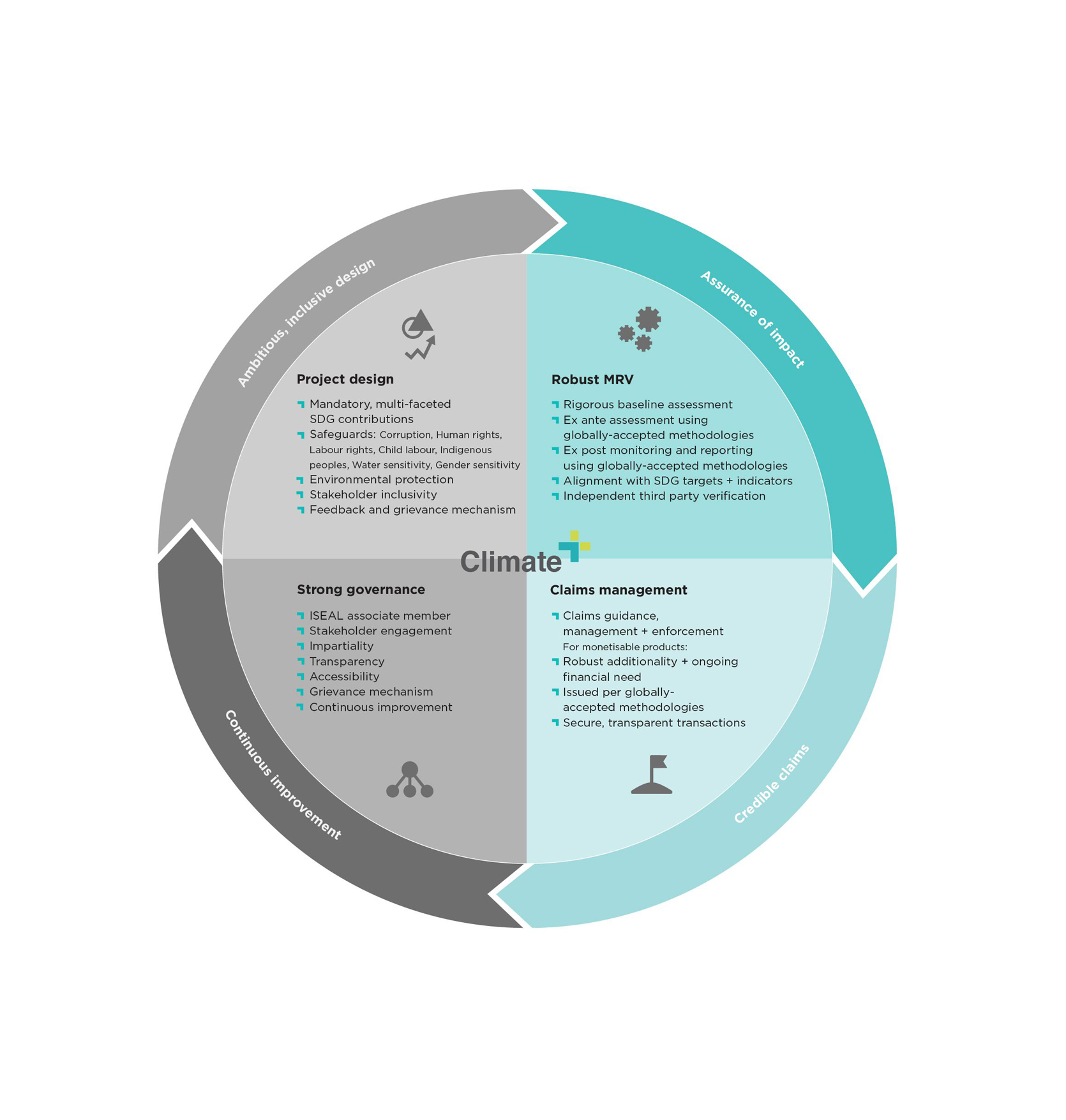
Gold Standard projects deliver the greatest impact and place a high value on certainty of outcomes and credibility of claims.
Gold Standard is an Associate Member of ISEAL, which sets the standard for these processes and principles, including transparency, impartiality, stakeholder engagement, grievance management, and efficiency as well collaboration with other standards for exponential impact.
Standards vary in if or how they feature these quality measures. For example, in some standards, safeguards are optional, not mandatory. So it’s best to understand your priorities and ask some key questions before making your choice in carbon credits.
Gold Standard mantra is “making good better.” This means that we commit to continue pioneering in climate protection to ensure the most stringent safeguards and the greatest impact delivered for every dollar channeled to projects.
THE MINIMUM REQUIREMENTS
Even organisations that are focused solely on climate impact – or prioritise lowest cost – should take care to ensure that their credits are from a reputable source. Do the carbon credits represent the minimum integrity related to climate impact? Be sure the carbon credits have these attributes to ensure integrity of their climate impact:
CERTIFIED
Projects follow internationally recognised standard requirements for best practices and are certified against those standards.
REAL
Emission reductions are based on an accurate baseline and have been credibly quantified
ADDITIONAL
Emission reductions would not have happened without the project activity.
INDEPENDENTLY VERIFIED
Project activities and impact data are verified by independent third party auditors
UNIQUE
Carbon credits are not counted or claimed by another party.
TRACEABLE
All project impacts, including the carbon credits themselves, are tracked transparently in a public registry.
COMMITTED TO HIGHEST QUALITY + IMPACT IN SUSTAINABLE DEVELOPMENT
Many people interested in offsetting are motivated by specific benefits that are important to them, like gender equality, poverty reduction or access to clean water. Others seek to support projects in certain geographies. To ensure all sustainable development claims beyond climate impact are credible, ask:
- Does the project deliver multiple sustainable development benefits?
- Are those benefits monitored and independently verified?
- Has the project been designed in a gender sensitive way?
PRO TIP: Even if you see an SDG icon on marketing material, ask to see monitoring and verification reports for those impacts
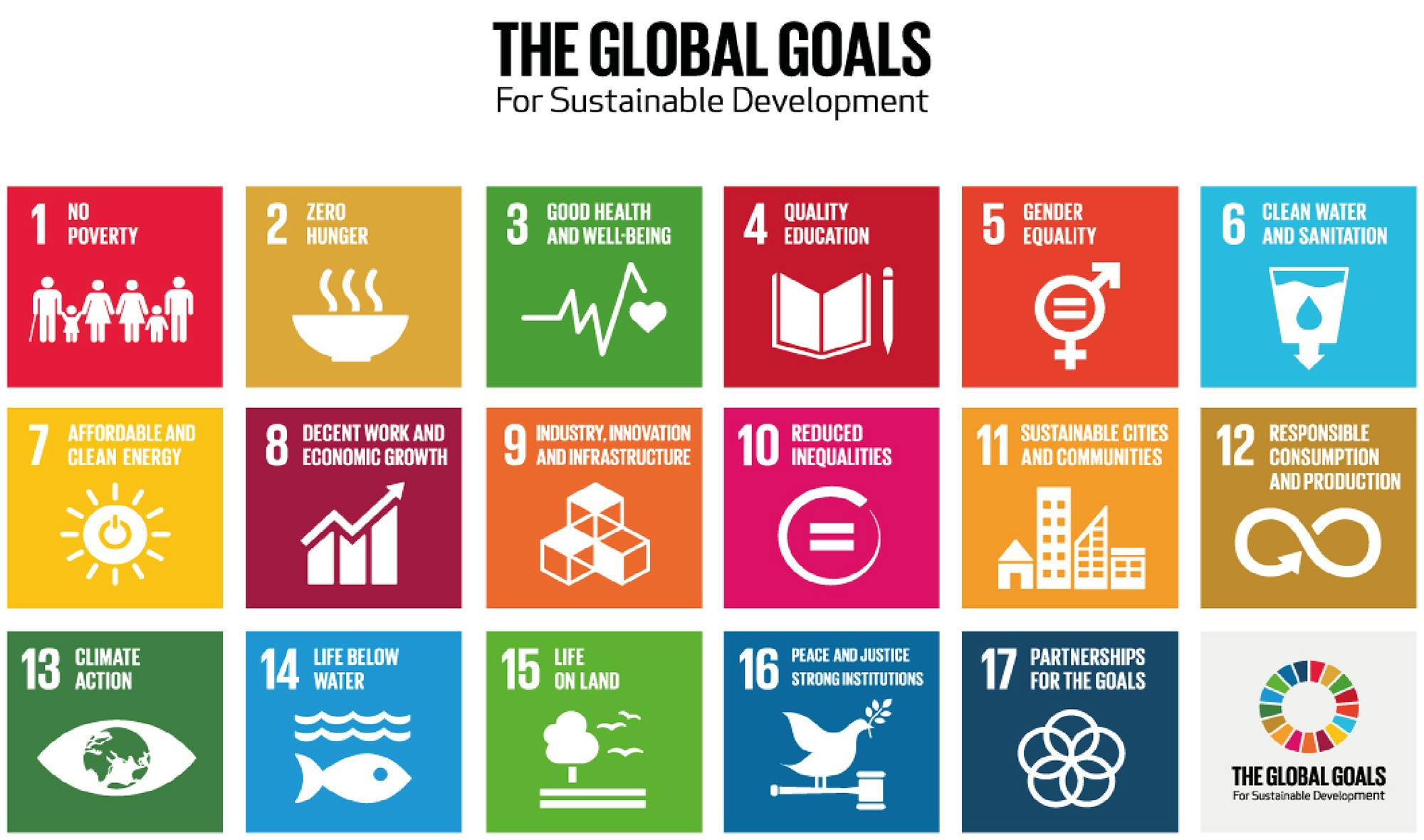
THE GOLD STANDARD DIFFERENCE
Credible standards provide quality, independently verified assessments of the emission reductions produced by a project, ie, its climate impact. The Gold Standard goes further and ensures that all its projects meet robust and stringent methodology requirements for sustainable development in the local area.
SAFEGUARDS
It’s mandatory (not optional) for ALL Gold Standard projects to follow ALL relevant environmental and safeguarding principles in order to
be certified.
STAKEHOLDER INCLUSIVITY
This includes local stakeholder consultations and access to a grievance mechanism in case there are issues with the projects.
GENDER-SENSIVITY
All Gold Standard for the Global Goals projects must follow Gender-sensitive design principles, which is unique to Gold Standard.
PROJECT ELIGIBILITY
Higher-risk project types like fossil fuel switch or large hydro are not eligible for Gold Standard certification.
VERIFIED SDG IMPACT
All Gold Standard projects must deliver impact toward a minimum of 3 Sustainable Development Goals (SDGs), including climate. These SDG benefits vary according to project type and are verified by an independent third party.
HOW TO CHOOSE BETWEEN DIFFERENT PROJECTS?
Different projects provide different benefits. For example, a large-scale wind project provides more country level benefits such as better access to clean technologies, local employment opportunities, more energy independence and increased social stability. An improved cookstove project, on the other hand, benefits people at a community level by decreasing indoor air pollution, improving health (predominantly among women and children).
Less wood is required helping to decrease deforestation and saving families money, and less time is needed for collecting wood, providing more opportunities for schooling and social activities.
Following are examples of common climate protection projects, the different development benefits they deliver, and the tangible economic value created by these benefits. NOTE: $ values are given in 2017 USD
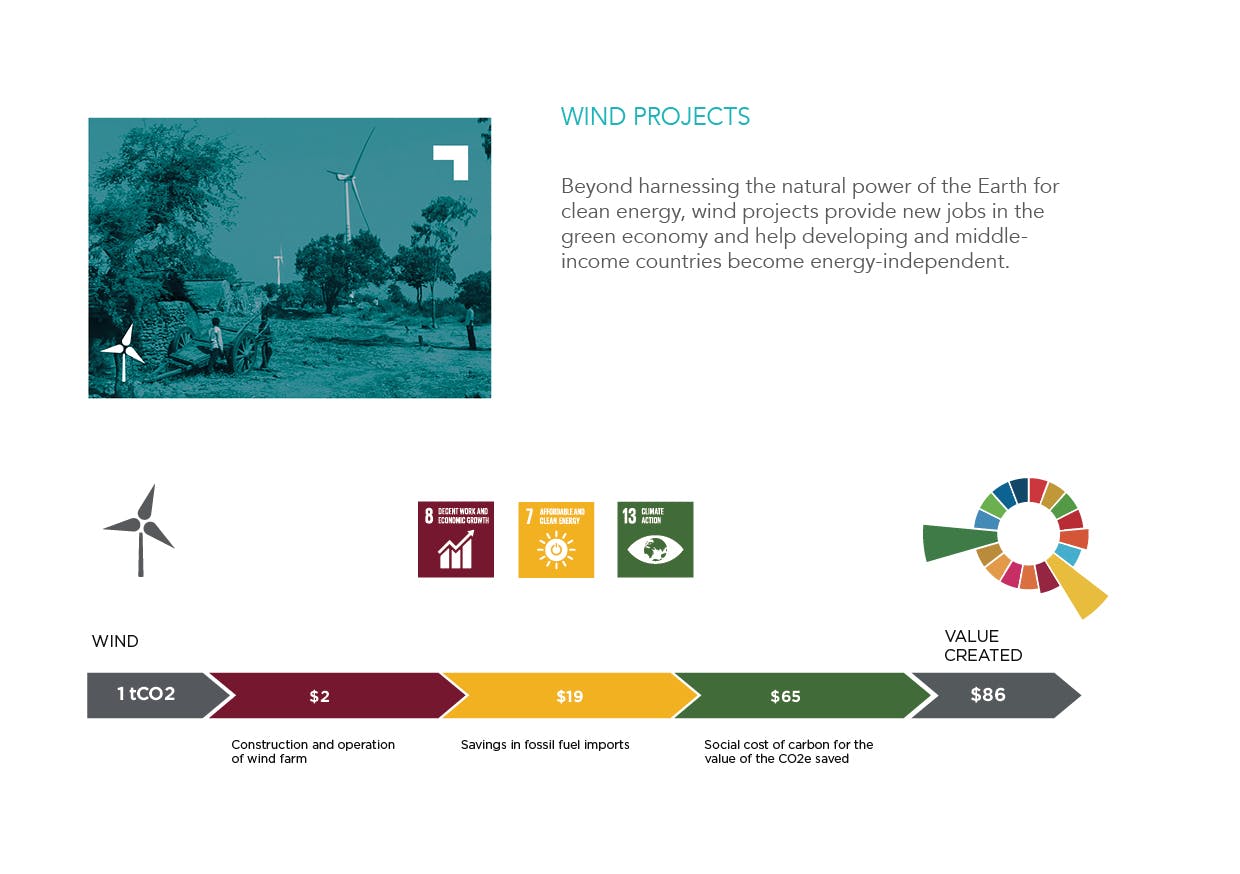
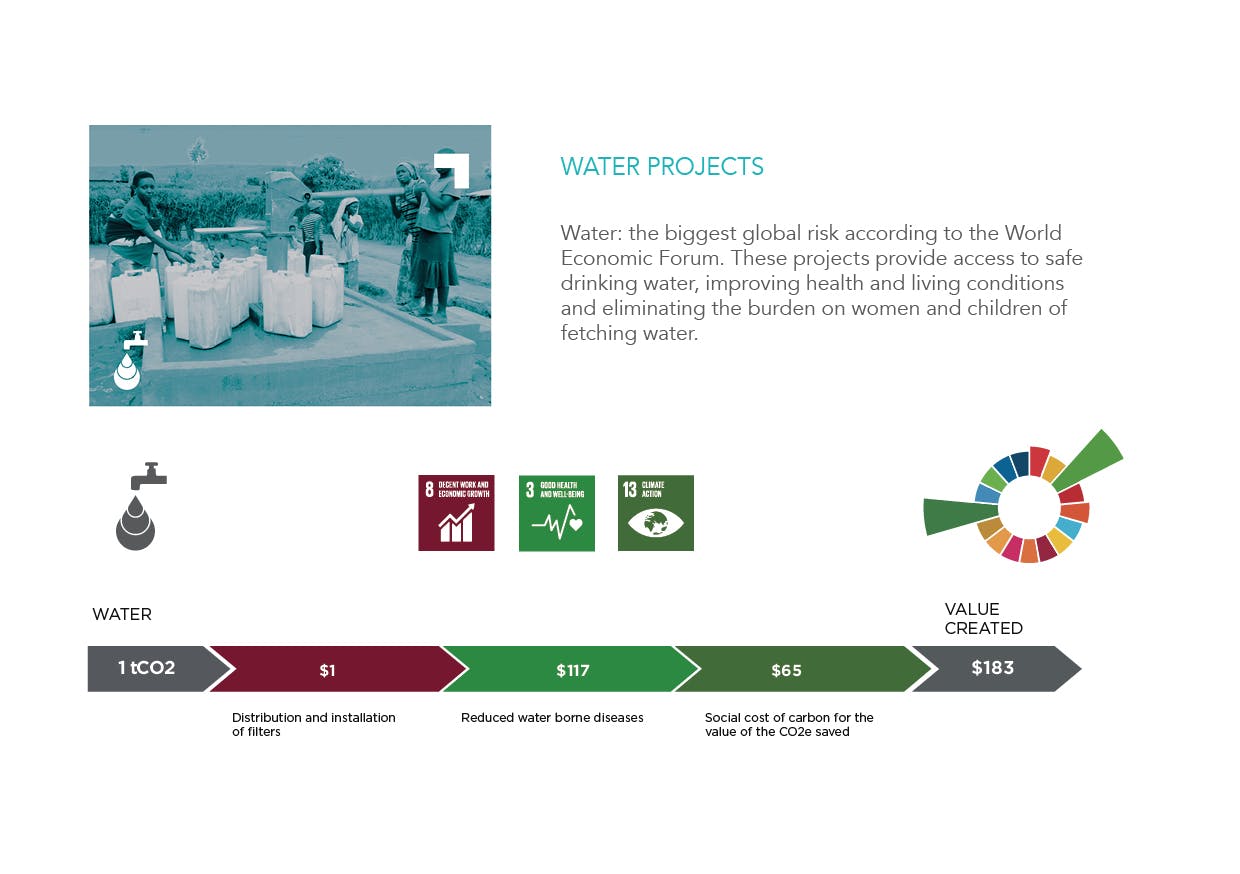

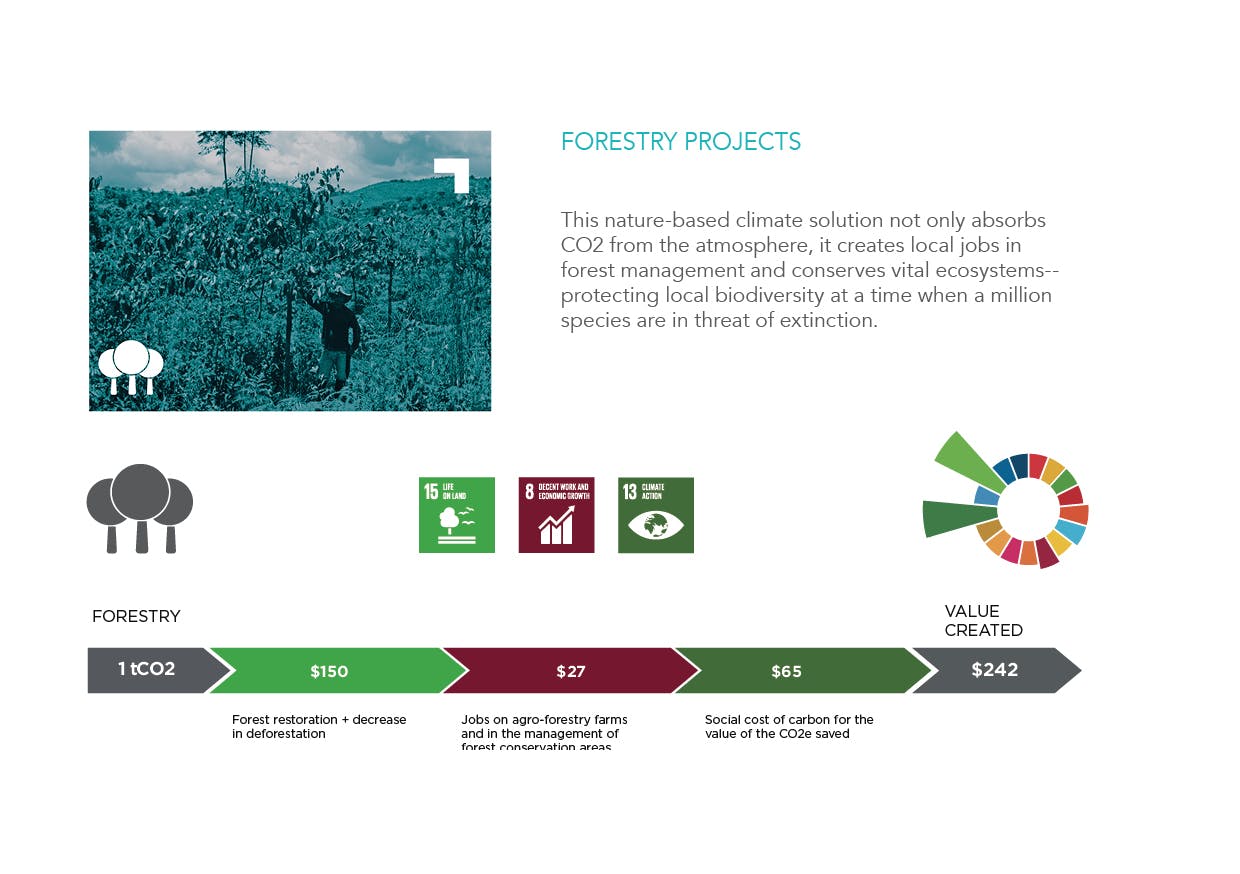

3.3 What is a carbon credit worth?
If you’re confident you found the right projects to support based on your priorities, the next question is price. What does a carbon credit cost?
WHAT IS A CARBON CREDIT WORTH?
Though every carbon credit represents one tonne of CO2 equivalent, you may have seen a range of prices for these credits. Prices range for a variety of factors:
- Integrity of the standard its certified against
- Value associated with the beyond-climate sustainable development benefits delivered
- Preferences for different project types or geographies and associated supply and demand dynamics
- Costs required to plan, implement and monitor a project
Read more about how pricing is approached.
Gold Standard recommends using the Fairtrade carbon credit pricing model as a guide for minimum prices. For carbon credits sold through the Gold Standard website, we started with the Fairtrade minimum price and adjusted upwards to account for the value created by additional sustainable development benefits delivered by different types of projects beyond simply reducing carbon.
WHERE DOES MY MONEY GO?
Carbon offsetting projects operate on a results-based finance model. This means that the project developer takes on all the financial risk and makes the initial investment required to develop and certify the project. Once their project impacts have been independently verified and certified, the project is issued with carbon credits. The sale of these credits enables project developers to recoup costs, repay loans, and maintain and expand the project activity. This ‘payment for performance’ approach provides those supporting the project (e.g. purchasing carbon credits) with the highest assurance that the outcomes have been achieved.
If you would like to know more about where your money goes, here are some questions to ask your supplier:
- Where do the proceeds of your purchase go?
- How much money goes to the actual project developer versus the seller of the credits (if it’s not the same organisation)?
- Does the project report on how proceeds from carbon credit sales are used?
- Can you see your purchase tracked transparently in a public registry?
3.4. Where can I purchase carbon credits?
You’ve calculated your carbon footprint and you know the number of carbon credits you’d like to purchase, but where do you go or who do you contact to purchase these offsets?
HOW CAN I MAKE A PURCHASE?
For individuals + small businesses: For individuals + small businesses:
1. Purchase online via the Gold Standard website.
You can purchase credits from Gold Standard certified climate protection via our website. 80% of the proceeds go back to the project developers to help them maintain and expand their projects. The remaining 20% is used to cover VAT where applicable, variable PayPal and bank charges, and the administration costs for maintaining the platform and transparently retiring the credits.
Prices are set using the Fairtrade carbon credit pricing model as the minimum starting point and are adjusted upwards according to the size, complexity and added benefits delivered beyond simply reducing carbon.
The carbon credits you purchase are instantly and transparently retired in the Impact Registry. On completion of an order you receive an email confirmation from Gold Standard and a follow-up email with the purchase certificate and direct links to the credit retirements.
Visit Gold Standard Marketplace here.
For larger purchases:
1. Direct from the project developers
The Gold Standard Impact Registry lists all the projects certified to Gold Standard. You can search and filter the projects that meet your strategic objectives and reach out to the project developers directly to make a purchase.
2. Use a carbon consultant or retailer
International carbon consultants and retailers provide advice and can assist you to quantify your carbon footprint and select the right offsets to meet your specific needs. You can find a list of reputable carbon consultants and retailers at the International Carbon Reduction and Offset Alliance (ICROA) website.
Remember to ask them how much of the money you pay goes directly to the project developer. You may also want to ask if the project developer reports on how it uses carbon credit income.
4. Spread the word!
We encourage you to inspire even more people to take action against climate change.
4.1 READY TO USE SOCIAL NETWORKS ASSETS
4.2 INTERESTED IN LEARNING MORE?
PUBLICATIONS
Here is a list of useful reports and publications.
- Special Report - Global Warming of 1.5C,
The Intergovernmental Panel on Climate Change (IPCC), October 2018 - Valuating the benefits of improved cooking solutions,
Vivid Economics, June 2019 - The real value of robust climate action,
Net Balance, May 2014 - Gold Standard Market Report 2019,
Gold Standard, March 2020 - EcoSystem Marketplace: State of the Voluntary Carbon Market Reports,
Forest Trends, December 2019 - State and Trends of Carbon Pricing 2019,
World Bank, June 2019 - What makes a high-quality carbon credit?,
WWF, June 2020 - Greenhouse Gas Management Institute Resources,
GHGMI courses on climate change
GLOSSARY of ACRONYMS
Visit out glossary here.
